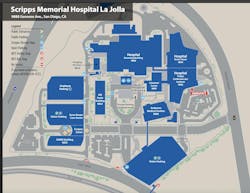A new inpatient healthcare tower opens for business in San Diego
On June 1, the eight-story, 420,000-sf Scripps Memorial Hospital La Jolla North Tower in San Diego officially began receiving patients. This $664 million acute-care facility, which is directly connected to the Prebys Cardiovascular Institute, includes 188 inpatient beds, a rooftop helistop, nine operating rooms, three interventional radiology suites, and expanded imaging, NICU, labor and delivery, and postpartum services.
This project took 52 months to complete, and its construction was the first of its kind for the California Department of Health Care Access and Information to deploy a bolted side plate structural steel system.
Using that system “offered us a couple of significant advantages,” said Chris Delgado, Project Director for McCarthy Building Companies, the GC on the hospital tower, in an interview with BD+C. “First, it reduced the overall erection time compared to a conventional welded system, allowing us to accelerate the schedule. It also created labor savings, since we didn’t need as many welders onsite. Rather than welding every connection, most were bolted, with welding required primarily at the splice floors where column sections were joined. That approach helped improve efficiency and supported our efforts to maintain momentum during construction.”
Other time-saving construction techniques included using precast paneling to reduce building enclosure timelines. McCarthy self-performed the project’s work on concrete, underground utilities, mapping. The building also has new chillers, cooling towers, and generators.
The precast panels and the bolted side plate steel system both streamlined the exterior construction process and reduced time in the field, said Delgado.
Project accentuates legacy relationships
One of the main challenges was constructing the new tower adjacent to an active hospital, including an operational helipad located within our construction fence. McCarthy established a communication protocol with the hospital’s radio room so that any time an inbound helicopter approached, iits team received a direct call. “We would then halt work—especially crane operations in the flight path—to let the helicopter land and offload the patient and resume activities after it departed. That protocol worked seamlessly throughout the project,” said Delgado.
Another key complexity was connecting the new tower to the existing Prebys Cardiovascular Institute. Those connections spanned multiple floors—2M through 7—via a structural bridge that also incorporated offices and corridors. Fortunately, said Delgado, when Tower One was built, “we had already installed the structural infrastructure needed for these connections, which allowed us to integrate them with minimal disruption.”
The North Tower’s Building Team included Scripps Health and HGA Architects.
What makes this project unique, said Delgado, is that it incorporates some of the latest advancements in healthcare environments while building on McCarthy’s nearly two decades of partnership with Scripps.
For example, he elaborated, the operating rooms feature a modular clean suite ceiling system. Unlike conventional drywall ceilings, this system allows Scripps to reconfigure the operating room layout and adapt to new technology over time—whether it’s updated booms or evolving surgical equipment without major reconstruction.
This tower expands state-of-the-art care for mothers and babies on the same campus where McCarthy delivered the first tower in 2014. The North Tower “is more than just a building—it’s about creating a lasting positive impact on the community and optimal care for all patients,” said Delgado.
“About 3,200 babies are delivered at Scripps La Jolla each year,” said Ronald Salzetti, MD, department chair of obstetrics and gynecology for Scripps Clinic, in a prepared statement. “The opening of the North Tower ensures that those infants and their mothers will continue to receive the very best care possible in a place that was built with the future in mind, allowing for services and technology to evolve as medicine continues to advance.” Eighty-two of the tower’s inpatient beds will serve mothers and babies.
According to Chief Healthcare Executive’s website, Scripps Health is undertaking other expansion plans that include a $1.2 billion medical complex in San Marcos, Calif.
About the Author

John Caulfield
John Caulfield is Senior Editor with Building Design + Construction Magazine.


